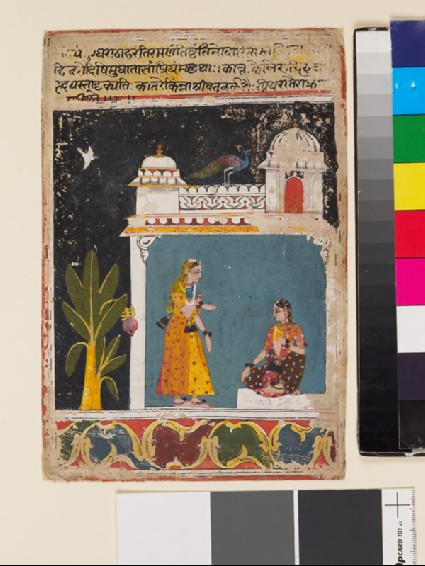Browse: 1 object
- Reference URL
Actions
The sakhi's exhortation, from the Amaru Sataka
-
Details
- Series
- One hundred verses of Amaru
- Associated place
-
Asia › India › central India › Madhya Pradesh (place of creation)
- Date
- late 17th century
- Material and technique
- gouache on paper
- Dimensions
-
mount 40.2 x 27.6 cm (height x width)
page 21.7 x 24.7 cm (height x width)
painting 17.6 x 13.5 cm (height x width)
- Material index
- Technique index
- Object type index
- No. of items
- 1
- Credit line
- Purchased, 1979.
- Accession no.
- EA1979.13
-
Further reading
Harle, J. C., and Andrew Topsfield, Indian Art in the Ashmolean Museum (Oxford: Ashmolean Museum, 1987), no. 87 on p. 79, illus. p. 79
Location
-
- currently in research collection
Objects are sometimes moved to a different location. Our object location data is usually updated on a monthly basis. Contact the Jameel Study Centre if you are planning to visit the museum to see a particular object on display, or would like to arrange an appointment to see an object in our reserve collections.
Publications online
-

Indian Art in the Ashmolean Museum
During the 18th century a forceful style of illustrative painting flourished at the Hindu courts of the Malwa and Bundelkhand regions in Central India; very little inscriptional evidence has come to light that would help distinguish its main local variants. Even more than contemporary work in Rajasthan to the west, the so-called Malwa style is a continuation of an indigenous 16th century painting tradition, with less of the subsequent refining overlay of Mughal influence than elsewhere. It remains primitive and direct in form and colouring, sometimes tending to stiffness and repetitiveness. As at the other Rajput courts, the usual subject matter includes scenes from the religious epics, rāgamālā themes [see EA1958.148] and, not least, poetical texts describing the emotions and behaviours of lovers, such as the Hindi Rasikpariyā of Kesava Dās and – more often illustrated in Central India than elsewhere – the Sanskrit verses of Amaru. This page from a series of the Amaru-Śataka (Hundred verses of Amaru) depicts a confidante (sakhī) remonstrating with a disconsolate heroine, who has been neglected by her unfaithful lover. Making an appropriate gesture, the sakhī exhorts her: “Women, wicked despite their loveliness, are stealing your only delight away and, though forbidden, they do not desist. Why do you suffer and weep in vain? Do them no such favours. Why not confront your beloved amorous tender-hearted young husband, my disheartened one, with a hundred loving, a hundred cruel harsh words and be your own best advocate?” The scene is set within a palace chamber, with a plain blue interior and black sky which silhouettes a flying bird, a peacock on the palace roof and a plantain tree with its pendulous flower. The band of formalized scrollwork below is a common feature of this series.
© 2013 University of Oxford - Ashmolean Museum

